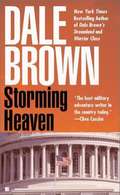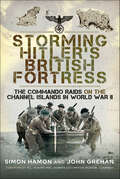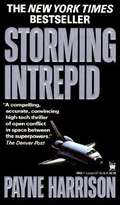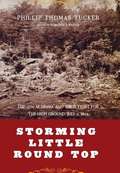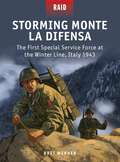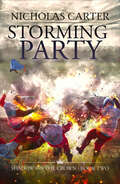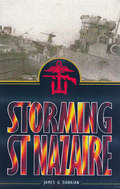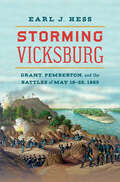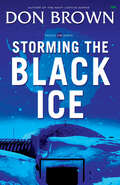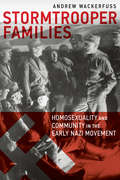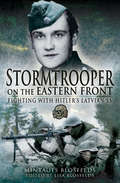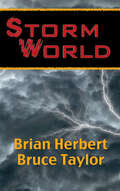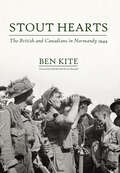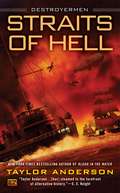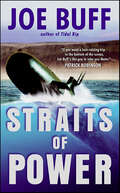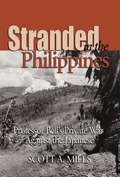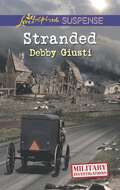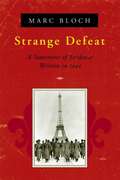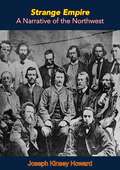- Table View
- List View
Storming Heaven (Independent #4)
by Dale BrownAbused by American soldiers during an incarceration in Europe, Henri Cazaux has waited years to exact revenge on the U.S. He uses commercial aircraft to deploy bombs on major U.S. airports--killing thousands, halting air traffic, and creating national panic. Rear Admiral Ian Hardcastle and It. Col. Al Vincenti are ordered to reestablish security in the skies.
Storming Hitler's British Fortress: The Commando Raids on the Channel Islands in World War II
by John Grehan Simon HamonIn 1940 British forces were withdrawn from the Channel Islands, allowing the Germans to occupy British territory. Hitler was determined to hold onto what he saw as a valuable prize, and the islands were heavily fortified. However, despite being extensively defended, the occupied Channel Islands remained vulnerable to commando-style raids. Indeed, a total of nine such operations were conducted between 1940 and 1943. Many others were planned but never executed. Each one was a bold and dangerous expedition, with small groups of men daring to trespass on Hitler’s cherished British stronghold. The first of these attacks, Operation Ambassador, took place on the night of 14/15 July 1940. The second ever raid undertaken by the Commandos, it was focused on the island of Guernsey. Though the mission failed to achieve any of its objectives, valuable lessons were learnt. In the weeks, months and years that followed, raids were also undertaken against Jersey, Sark, Herm, Burhou and the Casquets lighthouse off Alderney. The final attack, Hardtack 22, was one of the three carried out against the German garrison on Sark. After the second mission, Hardtack 7, had to be aborted, the Commandos returned to the island on the night of 26/27 December 1943, tasked with undertaking a reconnaissance and capturing prisoners. This too was a failure after the raiders entered a minefield; two men were killed and most of the others wounded. Compiled from official reports and first-hand accounts, each of the raids is packed with intrigue and drama – including the fear of reprisals being taken against the islanders. Each of the missions are explored on the ground today by the authors, with the routes taken and all key locations relating to each attack photographed and described. The planned but never executed raids are also explored. Never before have these stories been told in such detail, and never before in the words of those that took part in the raids and those who ultimately, were most affected.
Storming Intrepid
by Payne HarrisonONE HIJACKED SHUTTLE OUT OF CONTROL IN OUTER SPACE. The crippled space shuttle INTREPID is carrying top secret Star Wars technology-and it appears that a Russian agent is in command. If the Soviets get to that pay load before the Americans, the consequences are unthinkable. What began as a routine voyage turns into a harrowing nightmare in outer space as the top echelons of intelligence, military and aerospace combine forces in a desperate bid to stop the Russians. The President's prepared to use everything from stealth bombers and SR-71 Blackbirds to untested space fighters as this precedent-shattering confrontation hurtles to its tension-crackling climax.
Storming Little Round Top: The 15th Alabama and Their Fight for the High Ground, July 2, 1863
by Philip Thomas TuckerA detailed study of the 15th Alabama's attack on Little Round Top during the Civil War.War.
Storming Monte La Difensa - The First Special Service Force at the Winter Line, Italy 1943
by Bret WernerFeaturing full-color artwork, archive photographs, and first-hand accounts from participants, Storming Monte la Difensa examines the origins, execution, and aftermath of the FSSF's spectacular success at Monte La Difensa amid the savage winter conditions of December 1943.In December 1943 Monte La Difensa was part of the formidable German defenses overlooking the Allies' route to Rome via Monte Cassino. In the First Special Service Force's first combat in the Mediterranean theater, the Force would employ its special training in mountain and winter warfare to scale the peak, capture it, and then hold it against the inevitable German counterattacks. Astonishing their superiors, the First Special Service Force had succeeded in the face of seemingly impossible odds, but suffered a 77 percent casualty rate. Their victory, founded on their aggressive doctrine and extensive training in a variety of combat techniques, would prove instrumental in the postwar development of special forces.
Storming Party (The Shadow on the Crown)
by Nicholas CarterRivalry and battle abound in this action-packed historical adventure of the English Civil War.1643:Sir William Waller’s army has been defeated on Roundway Down, his infantry left stranded on the bleak slopes at the mercy of the Royalist cavalry. Sir Ralph Hopton is now free to turn his attention to Parliament’s bastion in the West – Bristol. The city walls are strong enough but Bristol has precious few men and even fewer guns with which to defend them. And to make matters worse, rumour has it that Prince Rupert, the bane of Parliament's cause, is on his way from Oxford to reinforce Hopton.But for William Sparrow, captured on Roundway, such fears are distant. His fight against the King seems to be over and he is to be sold into slavery and shipped to the West Indies. Hugo Telling has fallen victim to confused fighting and is a prisoner of Parliament. The war between the two men for Bella Morrison’s affections is at an impasse…The second thrilling instalment of The Shadow on the Crown series, Storming Party is perfect for fans of David Gilman and Bernard Cornwell.Praise for Nicholas Carter‘Paints a vivid and accurate picture of seventeenth-century battle’ Richard Holmes, author of Firing Line‘Quite simply the best description of men in battle I have ever come across’ John Lee, British Commission for Military History
Storming St. Nazaire: The Gripping Story Of The Dock-busting Raid, March, 1942
by James DorrianThe St. Nazaire raid has not been covered in the detail warranted by its role in the evolution of special warfare tactics. James Dorrian has drawn on interviews with over 100 survivors, both British and German, to present this remarkable account. All aspects of the engagement are covered, including the final ironic incident that resulted in more German casualties than the main battle itself.
Storming Vicksburg: Grant, Pemberton, and the Battles of May 19-22, 1863 (Civil War America)
by Earl J. HessThe most overlooked phase of the Union campaign to capture Vicksburg, Mississippi, was the time period from May 18 to May 25, 1863, when Ulysses S. Grant closed in on the city and attempted to storm its defenses. Federal forces mounted a limited attack on May 19 and failed to break through Confederate lines. After two days of preparation, Grant's forces mounted a much larger assault. Although the Army of the Tennessee had defeated Confederates under John C. Pemberton at Champion Hill on May 16 and Big Black River on May 17, the defenders yet again repelled Grant's May 22 attack. The Gibraltar of the Confederacy would not fall until a six-week siege ended with Confederate surrender on July 4. In Storming Vicksburg, military historian Earl J. Hess reveals how a combination of rugged terrain, poor coordination, and low battlefield morale among Union troops influenced the result of the largest attack mounted by Grant's Army of the Tennessee. Using definitive research in unpublished personal accounts and other underutilized archives, Hess makes clear that events of May 19–22 were crucial to the Vicksburg campaign's outcome and shed important light on Grant's generalship, Confederate defensive strategy, and the experience of common soldiers as an influence on battlefield outcomes.
Storming the Black Ice (Pacific Rim Series #3)
by Don BrownWhen British geologists discover the world's largest oil reserves under the desolate, icy tundra of Antarctica, Britain and Chile form a top-secret alliance for control of petroleum resources that will rival the economic power of OPEC.But when their discovery is uncovered by an Argentinean intelligence officer, a surprise-attack against a secret British outpost in Antarctica triggers a war. Britain and Chile are in a military standoff against Venezuela and Argentina, and when the war escalates, Britain asks America for help.For two couples separated by the battle, the outcome will be either love reunited or devastating heartbreak.For a young British boy living with his mother in London, his father&’s life is on the line.And for Pete Miranda, an American sub commander detailed on a special military assignment to his father's homeland of Chile, will his fate be a crushing death under the icy-cold waters of the Antarctic Ocean, or a future of life, light, and a second chance for love?
Stormtrooper Families: Homosexuality and Community in the Early Nazi Movement
by Andrew WackerfussBased on extensive archival work, Stormtrooper Families combines stormtrooper personnel records, Nazi Party autobiographies, published and unpublished memoirs, personal letters, court records, and police-surveillance records to paint a picture of the stormtrooper movement as an organic product of its local community, its web of interpersonal relationships, and its intensely emotional internal struggles. Extensive analysis of Nazi-era media across the political spectrum shows how the public debate over homosexuality proved just as important to political outcomes as did the actual presence of homosexuals in fascist and antifascist politics.As children in the late-imperial period, the stormtroopers witnessed the first German debates over homosexuality and political life. As young adults, they verbally and physically battled over these definitions, bringing conflicts over homosexuality and masculinity into the center of Weimar Germany's most important political debates. Stormtrooper Families chronicles the stormtroopers' personal, political, and sexual struggles to explain not only how individual gay men existed within the Nazi movement but also how the public meaning of homosexuality affected fascist and antifascist politics—a public controversy still alive today.
Stormtrooper on the Eastern Front: Fighting with Hitler's Latvian SS
by Mintauts BlosfeldsThe memoir of a reluctant soldier coerced into military service by the Nazis and driven from his homeland by the Russians. Following the conquest of his native Latvia by the Nazis, Mintauts Blosfelds was given the stark choice: service in the SS or forced labor in a slave camp. So he &“volunteered&” to fight for the Nazis. In this memoir he describes his training and how he became an instructor before being sent into Russia. He nearly perished during the terrible winter of 1943–44 after being wounded and finding himself with his friend lying dead on top of him. As the tide turned, the Russians advanced remorselessly through. He would be wounded twice more and awarded the Iron Cross for bravery. With German resistance collapsing, he had to flee for his life—capture by the Russians meant almost certain death. He surrendered to the Americans, but describes the neglect he suffered at their hands. Unable to return to Latvia, which was now occupied by the Russians, he became a Displaced Person, eventually settling in the UK. This book tells his compelling story.
Stormworld
by Brian HerbertThe Wolfe Pack series is military science fiction with a twist! The auxiliary scout platoon known as the Cockroaches contains all the outsiders and oddballs the Galactic Defense Force doesn’t want to have to deal with, but can’t find a way to discharge from the Space Service. They’re savvy, street-smart, wise (if not book-learned), intelligent, survival-oriented, and completely unconventional. Lt. David Wolfe is their new CO: young, idealistic, and gung-ho, but even he has a secret that forced Central Command to shift him out of the line of fire. The Cockroaches get sent on what ought to be a simple courier mission to the greatest amusement park in the Galaxy, and end up defending the population from a ruthless enemy in the only way the Cockroaches know how: unconventionally!
Stormy Skies at the Beach Hotel: A page-turning, emotional WW1 saga (Beach Hotel Series)
by Francesca CapaldiA new arrival at the Beach Hotel spells trouble Chambermaid Fanny is thanking her lucky stars she has had a second chance at life. As an unmarried mother, it could have been very different and she is happy. But when new maid, Susie, arrives at the Beach Hotel, it isn't long before sparks fly. Susie begins to meddle in Fanny's friendships and even in her budding romance with Walter, an American working at the aerodrome. Meanwhile, a flu epidemic starts to spread and as more people fall ill, the hotel is forced to close. Matters come to a head when Susie plots to reveal secrets about Fanny that could spell her ruin. Can the hotel and the hardworking women who run it survive? An uplifting, emotional WW1 saga perfect for fans of Ginny Bell and Jean Fullerton Readers adore the Beach Hotel series: ‘Oh wow this story was…amazing and heartfelt…I hope there will be more in this series’***** Reader Review ‘Another brilliant book by this brilliant author.’ ***** Reader Review ‘Brilliant storyline, brilliant book. Couldn’t put it down. Family saga at its best.’***** Reader Review ‘I loved this enchanting read…could not put it down.’***** Reader Review ‘Well, what a start to a new series! There are many secrets to be uncovered…I loved this book.’***** Reader Review ‘Had me turning the pages well into the night… A five-star, well-written beach caper. A page turner from beginning to end.’***** Reader Review ‘Charming…this book felt like an escape…The story was heartwarming.’***** Reader Review ‘I thoroughly enjoyed this book…I’m glad there is more to come from the Beach Hotel.’***** Reader Review ‘I have enjoyed all three books in this series but this one was the best! I think that is because it is Helen’s story and Helen is the very heart of the hotel…I really enjoyed it.’***** Reader Review ‘The strong thread that runs through this series is friendship, that’s exactly what Helen Bygrove needs when things get difficult! I know it was third in series but I’m sure there’s room for a follow up! I live in hope.’***** Reader Review
Story of Now: Let's Talk about the British Empire
by Shelina JanmohamedThe UK was once a huge global superpower. Bigger than the Roman Empire. Bigger than the Incas, Mayas, Aztecs, Mughal, Ottoman or any other European, Asian, African or American power. Its influence was felt in countries all over the world, but it didn't just affect countries over there. It affected everything about the islands we live on today. It affected the language we speak, the food we eat, the buildings that surround us, the people who live here, and the prosperity we enjoy. It is who we are today.And yet while we teach our children about the Romans, Egyptians, Mughals, Ottomans and other empires, we breathe barely a word about the biggest, wealthiest, most powerful and most influential superpower ever.From the Industrial North to the grandchildren of the Windrush generation, to children in overseas territories and former colonies, to those whose families came here fleeing persecution, this book will examine the modern culture of Britain, the Commonwealth and all countries historically connected to her past. It will look at identity and encourage children to discover and celebrate their own stories and the ways we are all connected to each other.
Stout Hearts: The British and Canadians in Normandy 1944
by Ben Kite“At last a book has been written that forensically examines how the British Armed Forces fought its way through Normandy . . . utterly absorbing.” —James Holland, bestselling author of Brothers in ArmsStout Hearts is a book which offers an entirely new perspective on the British Army in Normandy. This fresh study explores the anatomy of war through the Army’s operations in the summer of 1944, informing and entertaining the general nonfiction reader as well as students of military history. There have been so many books written on Normandy that the publication of another one might appear superfluous. However most books have focused on narrating the conduct of the battle, describing the factors that influenced its outcome, or debating the relative merits of the armies and their generals. What was missing from the existing body of work on Normandy specifically and the Second World War generally is a book that explains how an army actually operates in war and what it was like for those involved; Stout Hearts fills this gap.Stout Hearts is essential reading for those who wish to understand the “mechanics” of battle. How does an Army care for its wounded? How do combat engineers cross obstacles? How do tanks fight? How do Air and Naval Forces support the Army? But to understand what makes an Army “tick” you must also understand its people. Therefore explanations of tactics and techniques are not only well illustrated with excellent photographs and high quality maps but also effectively combined with relevant accounts from the combatants themselves. These dramatic stories of ordinary people doing extraordinary things are the strength of the book, bringing the campaign to life and entertaining the reader.
Straight Up: A Dan Stagg Novel
by James LearWho is trying to kill the members of an elite special ops team that worked off the radar in Iraq in the '90s? It’s up to Dan Stagg to track down the survivors — the men with whom he stormed an undefended surveillance station, killing everyone inside. And now, many years later, the team is being targeted in what seems like a series of unrelated attacks. Dan teams up with his old comrade Al Benson, once a rising star of the USMC, now a respectable married civilian with a few secrets to hide. As they dig deeper into the secrets of the past, Dan discovers that Benson’s looking for more than just answers. An explosive affair threatens everyone’s future, and connects Dan to a past he thought he’d left behind.
Straits of Hell
by Taylor AndersonNew York Times bestselling author Taylor Anderson's phenomenal alternate history Destroyermen series continues as a game-changing conspiracy throws the hope of honor, trust, and survival into chaos.... Matt Reddy's old Asiatic Fleet destroyer USS Walker has been mysteriously transported to an alternate version of earth. Here WWII is no longer raging, and Reddy and his crew have been trying to find a new place for themselves in this strange new world.Now, along with the felinoid Lemurians and Imperial allies, they fight to keep the reptilian Grik, a race growing in supremacy, from reconquering the Lemurians' ancestral home on Madagascar. Reddy and his crew are exhausted, far from reinforcements, and wildly outnumbered, so the odds seem greater than ever before. As for the fate of the Americas, Don Hernan and the evil Dominion have gathered to annihilate the forces behind the walls of Fort Defiance as a shadowy power with an agenda all its own rises with chilling resolve.As the war teeters on a knife-edge, a tipping point may have been reached at last--and cold steel and hot-blooded valor will remain the ultimate weapons.
Straits of Power (The Jeffrey Fuller Novels #5)
by Joe BuffIn his latest mission, Commander Jeffrey Fuller will go head–to–head against his most dangerous adversary yet – his own allies.Jeffrey Fuller has a new mission – use his cutting–edge submarine Challenger to recover a German spy claiming to have key information about the Berlin–Boer Axis, information that could be crucial to winning the war. Fuller will have to navigate his super–silent sub through some of the most densely patrolled waters in Europe if he hopes to accomplish his mission.But Fuller knows he can't trust the spy, code–named Zeno, an expert in electronic and information warfare. The man could be a double agent sent by the enemy to compromise Challenger. And when they finally recover the mysterious spy, he reveals that only by helping him infiltrate Israel can he hope to prevent an imminent Axis attack. Fuller is caught in a terrible dilemma – if the man is a double agent, he could be dooming Israel, but if he does nothing, the country could fall to the German assault. To go ahead with the plan would pitch Fuller against the best defences of his own allies, placing his crew in danger and possibly shattering bonds between nations. It is a battle that, if fought, Fuller will have to fight entirely on his own.
Stranded in the Philippines
by Scott A. MillsAmerican missionaries Henry Roy Bell and his wife Edna had been teaching in the Philippines at Silliman University for twenty years when the Japanese invaded the islands after the attack on Pearl Harbor. This is the story of their guerilla war against the Japanese, from the time they took to the hills until they were secretly evacuated by submarine three years later. At first willing only to provide food to the young men covertly fighting against the Japanese, Bell eventually became fully involved in the Filipino resistance movement and rose to the rank of major in an island-wide guerrilla army. With a price on his head and his capture eminent, Bell, his wife, and two teenage sons were smuggled across the island and, on February 6, 1944, escaped on board a cargo submarine delivering arms and ammunition to the guerrillas
Stranded with the Navy SEAL: A Military Romantic Suspense Novel (Team Twelve #1)
by Susan CliffFor one navy SEAL, danger and passion are brewing in paradiseWorking on a cruise ship was supposed to be the perfect distraction for chef Cady Crenshaw. Instead, it made her the perfect target. Abducted and thrown overboard into foreign waters, she has only one shot at survival…and it comes at the hands of an irresistible ally.Navy SEAL Logan Starke’s protective instincts were locked and loaded the moment he met Cady at the ship’s bar. When a violent struggle to take down her captors leaves Logan and Cady stranded on a deserted island, he leaps into rescue mode. But the hot sand and the even hotter attraction between them can’t be denied…and temptation could be the deadliest threat yet.
Stranded: Stranded Untraceable Dangerous Inheritance (Military Investigations #7)
by Debby GiustiAMISH COUNTRY REFUGE Colleen Brennan has one goal-take down her sister's killer. But chasing after evidence leaves her in the path of a tornado and stranded in an Amish community. With the killer nearby, Colleen must depend on the kindness of Special Agent Frank Gallagher. Although the army officer is recuperating from a battlefield injury, he wants to help the beautiful woman he rescued from the tornado's fury. He can tell she's hiding something important. But getting her to reveal her secrets may be his most dangerous mission ever. Military Investigations: Serving their country and solving crimes
Strange Allies: Britain, France and the Dilemmas of Disarmament and Security, 1929-1933 (Routledge Studies in Modern European History)
by Andrew WebsterStrange Allies examines three intersecting themes of fundamental importance to the international history of the period between the two world wars. First, and most broadly, it is a study of the international history of the pivotal ‘hinge years’, running from the onset of the Depression in late 1929 to the Nazi capture of power in Germany in early 1933. The second theme is the strategic relationship between Britain and France, the critical dynamic in the management of global and European international relations during this time of great fluidity and uncertainty. The most contentious and intractable issue that divided the two countries was the pursuit of international disarmament, which forms the third theme of the book. Strange Allies is based upon extensive research in British and French archives, as well as in the archives of the League of Nations in Geneva. The book’s focus on 1929–31 in particular makes a major contribution to the international history of the interwar period by re-examining the security and strategic policies of the second Labour government in Britain and of foreign minister Aristide Briand in the post-Locarno years in France. For 1931–33, the book looks at the impact of the great financial and economic crisis of 1931 on security and disarmament planning in Britain and France. It then considers the impact of the Anglo-French relationship on the instability of Europe and on the failure of the World Disarmament Conference. This book is the first detailed study of the Anglo-French relationship during a critical period which saw a reshaping of the boundaries of global security. Although the Anglo-French alliance is rightly seen to be pivotal to both the initial phase of implementing the Versailles settlement of 1919 and the efforts to contain Hitler and protect Europe after 1936, Strange Allies demonstrates the degree to which these states’ conflicting views of security were central to international relations in the years leading up to Hitler’s accession to power.
Strange Defeat: A Statement of Evidence written in 1940
by Marc BlochBloch takes a close look at the military failures he witnessed, examining why France was unable to respond to attack quickly and effectively. He gives a personal account of the battle of France, followed by a biting analysis of the generation between the wars.
Strange Dogs: An Expanse Novella (The Expanse)
by James S.A. CoreyFrom New York Times bestselling author James S. A. Corey... Like many before them, Cara and her family ventured through the gates as scientists and researchers, driven to carve out a new life and uncover the endless possibilities of the unexplored alien worlds now within reach. But soon the soldiers followed and under this new order Cara makes a discovery that will change everything. Set in the hard-scrabble world of the Expanse, Strange Dogs deepens James S. A. Corey's acclaimed series.The Expanse (now a major television series)Leviathan WakesCaliban's WarAbaddon's GateCibola BurnNemesis Games Babylon's AshesComing Soon:Persepolis RisingThe Expanse Short Fiction The Butcher of Anderson StationGods of RiskThe ChurnThe Vital AbyssDrive
Strange Empire: A Narrative of the Northwest
by Joseph Kinsey HowardThis is Joseph Kinsey Howard’s last major work. It describes for the first time in detail, the heroic struggle of a primitive people to establish their own empire in the heart of the North American continent.Throughout his lifetime, Joseph Kinsey Howard was absorbed by the fateful dream of these American primitives, the Métis: their fathers, the English, the French, the Scots frontiersmen; their mothers the Native Americans.“The compass of Strange Empire is the history of the resistance put up by people of mixed French and Indian blood and by their cousins, the Plains Indians, to the advance of the Canadian settlement frontier. Mr. Howard’s narrative...is outstanding, not because he has offered much that hitherto was not known about the events, but because of his sensitive delineation of the cultures of the Plainsmen.”—Douglas Kemp, The Beaver“Mr. Howard’s book...is history reflective of his humanity, as it is reflective of his integrity, his scholarship, his depth, his informed respect for language. It will endure as a contribution to historiography. “—A. B. Guthrie, Saturday Review“The author has sacrificed neither fact nor detail in bringing to life events which hitherto have escaped the attention of most historians. Recommended.”—J. E. Brown, Library Journal“A moving and brooding book.”—R. L. Neuberger, New York Times“Vivid and absorbing. This book describes one of the crucial struggles in the long war for the west. It is sound and significant history, written with ardor and skill.”—Walter Havighurst, Chicago Sunday Tribune
